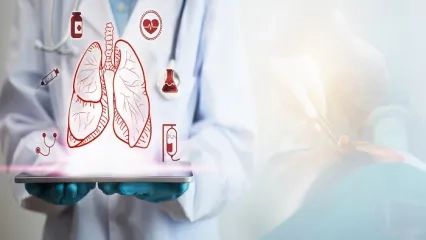Alo Yeditepe
Alo Yeditepe
The Cause of Shortness of Breath May be Trachea Stenosis
Yeditepe University Hospital Head of Chest Surgery Department Prof.Dr. Sina Ercan explained the shortness of breath that causes trachea stricture.
Stating that causes such as asthma, smoking addiction and heart diseases come to mind first in complaints of shortness of breath, Prof. Dr. Sina Ercan remarked in some rare cases, tracheal stenosis should be suspected.
“Shortness of breath is a very common problem in society. When it comes to shortness of breath, classic causes such as asthma, smoking, and heart disease always come to mind first. Because trachea stenosis is a rare cause that leads to shortness of breath." Yeditepe University Hospital Head of Chest Surgery Prof. Dr. Sina Ercan says that the main problem is that it is also overlooked because it is rare. However, this possibility should also be suspected in complaints of shortness of breath, Prof. Dr. Sina Ercan: “You cannot diagnose something that you do not suspect. When the cause of shortness of breath is shortness of the trachea and this is not diagnosed, patients can be treated incorrectly for a long time and see no benefit from these treatments.”
“What are the symptoms of trachea stenosis?”
“When it comes to shortness of breath in the patient, of course, it is natural to think of common causes first. However, when a patient who complains of shortness of breath and whose complaint is thought to be due to classical reasons such as asthma, heart disease, etc. does not respond to treatment for a long time. It is necessary not to be too persistent in treatment and to suspect tracheal stenosis. On the other hand, constant and unchanging wheezing can also be seen as another symptom. The patient's story should be well rested and, if necessary, a special film of the trachea should be requested. If there is a narrowing or obstruction in this way, it can be easily seen.”
A Respirator May Trigger Tracheal Stenosis
Stating that if the patient informs that he/she is in the intensive care unit and connected to the respirator in this process, this is a detail that should not be missed, Prof. Dr. Sina Ercan elaborates on this issue as follows: “The most common tracheal stenosis occurs as a callus, that is, as a reaction to an external effect. If a tissue is under pressure, a reaction occurs in that tissue and there may be a development that will cause stenosis. Such a situation may occur in patients who are connected to breathing instruments due to plastic pipes. These are hourglass-shaped contractions and have the effect of making the patient feel as if they are breathing through a straw.”
Surgical intervention is essential if there is a tumor
Stating that most airway stenoses are benign stenoses, Prof. Dr. Sina Ercan states that benign tumors that sometimes form inside the trachea and sometimes outside can also narrow the airway. He conveys the process after the narrowing is detected as follows:
“After narrowing is detected and its limits are determined by computed tomography, endoscopy or biopsy is performed for detailed diagnosis. Since the organ in question is the trachea in tumor-related obstructions, the tumor should be removed by surgery, whether benign or malignant, due to the risk of suffocation. In patients who cannot handle such surgery, if the tumor is outside the airway, a cage is sometimes placed to stop the pressure from inside. The tissue in question is destroyed by freezing or burning. Sometimes lasers are applied and sometimes expansion techniques are implemented.”
Repeated operations on the trachea are risky
Stating that it is very important to make the right decision from the beginning in tracheal stenosis operations, Prof. Dr. Sina Ercan explains this as follows: “In case of shortness of breath, the problem should be diagnosed early and acted on on time. The right technique must be applied. Making mistakes can cause permanent damage. Repeated operations on the trachea are risky. Therefore, it is important to achieve success in the first surgery. If the right methods are not applied, the treatment process may take too long and situations such as the loss of the voice that adversely affects the patient's health and quality of life, or the necessity of using a lifelong tracheostomy (plastic breathing tube attached to the trachea from the throat area) may occur."
This content was prepared by Yeditepe University Hospitals Medical Editorial Board.
”
See Also
- His Trachea was 95 Percent Closed, He Returned to Life with 10 Hours of Surgery
- He Couldn't Breathe; He Regained His Health with the Application of 3 Different Special Surgical Techniques Together
- Voice Can be Lost If Tracheal Stenosis is Not Detected Early
- Unable to Speak Due to Her Illness, Sibel: I Could Not Tell My Children 'I am Here' During the Earthquake
- Treated For Asthma For Two Years But Has Had A Tumour In Her Trachea
- Chance of Treatment in Patients Who Have a Tube Inserted in Their Throat to Breathe
- Young Man Who Lost His Voice Due to Tracheostomy Regained His Voice After Months
- It Is Possible to Prevent Possible Complications of Intubation
- The Tumor in the Trachea was Removed Without Damaging the Vocal Cords
- Survived Coronavirus, Had Windpipe Blockage Months Later, Returned From Death
- The Young Man Whose Trachea Was Completely Blocked After An Accident Regained Both His Health and His Voice
- What is Intubation?
- Lung Cancer
Alo Yeditepe



